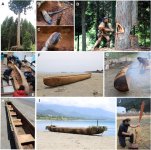
Japanese scientists made dugout canoe using only stone age tools, such as stone axes and fire, to test whether the Pacific Ocean could have been crossed by dugout paddlers, without maps, as long as 50,000 years ago.

They succeeded in their 140 mile test paddle across strong Pacific currents to an island. The scientists speculated that, if prehistoric man migrated from Asia to the Americas, he was more likely to have made such journeys in large dugout canoes than on rafts—such as Thor Heyerdahl's 1947 Peru-to-Polynesia journey on his Kon-Tiki raft—because rafts are too slow and unmanageable in strong Pacific currents.
HERE is a Smithsonian Magazine article on the experimental trip.
HERE is a scientific publication on the boat build and trip.
If Stone Age canoeists crossed the Pacific from Asia to North/South America, this would be a much earlier historical alternative than the Bering Straight Land Bridge theory for a land migration from Siberia to Alaska, which was made about 14,000 years ago during the last ice age according to most (but contested) archeological evidence.
